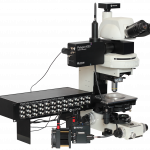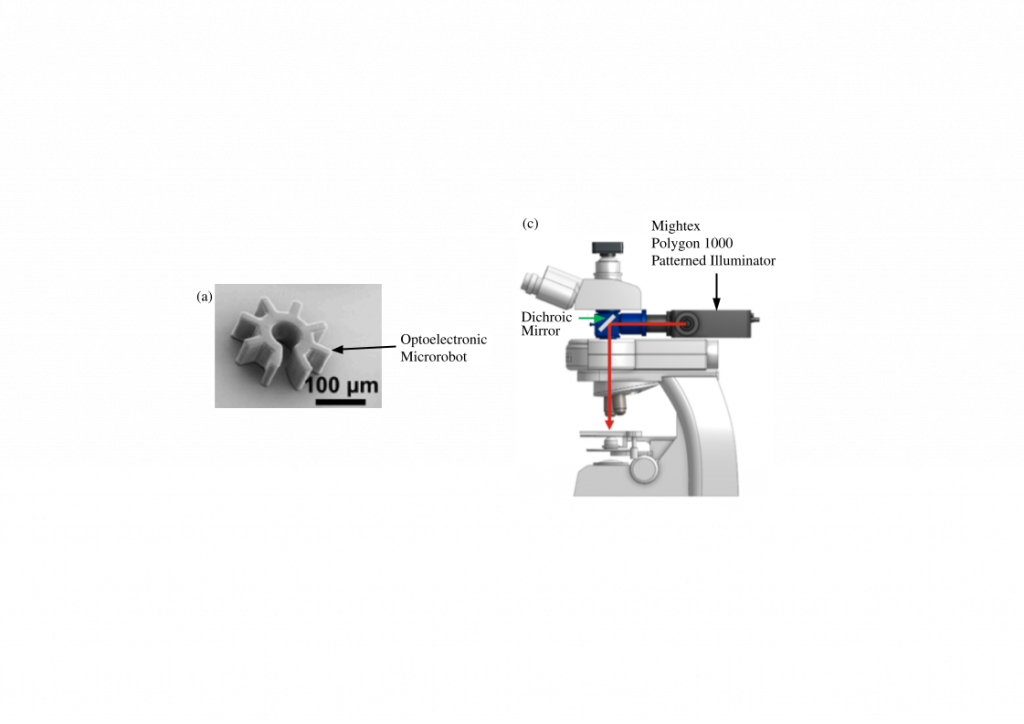Published on 2024/02/09 Research powered by Mightex’s Polygon1000 

Mohamed Elsayed & Aaron Wheeler, Single-cell isolation using the optoelectronic microrobot. University of Toronto, (2023).


The standard method that is used to isolate cells, fluorescence activated cell sorting (FACS) has many limitations, especially with cells that are sensitive to high shear stress [1]. Progress with such cells requires an approach that can gently isolate cells; here, we describe our efforts to use optoelectronic tweezer (OET)-controlled microrobots [Figure 1(a)] to achieve this goal.
OET uses light to manipulate micro-scale objects using dielectrophoresis (DEP) [2], and a new ‘microrobot’ strategy enables gentle manipulation of cells with minimal risk of electric-field mediated damage, as shown in Figure 1(b) [3]. Heterogenous populations of cells in a custom low-conductivity OET medium were manipulated by OET (via microrobots). The system features a network of microchannels and materials needed to apply light-driven DEP forces, using methods described previously [4] to reduce biofouling.
 (b)
(b)

Figure 1. (a) Scanning electron microscope (SEM) image of optoelectronic microrobot [3]. (b) Strategy for loading a cell into the optoelectronic microrobot, transporting it, then delivering it. (c) Optical setup, incorporating the Polygon1000.
Digital signals from a custom-built software were processed by a control module (BLS-IO04-US, Mightex Systems) to produce an analog signal for an LED driver with a maximum output of 13,000 mA (BLS-13000-1E, Mightex Systems) to drive the 625 nm 40W emitter LED (Mightex Systems). As shown in Figure 1(c), light from this LED was coupled to the DMD Patterned Illuminator (Polygon 1000, Mightex Systems) via a 3 mm 0.59 NA liquid lightguide (Mightex Systems). A 3-position adapter (DSI-3PS-LC-UA-PY, Mightex Systems) was installed in between the cube turret and the trinocular eyepiece.
The effects of temperature and viscosity on OET manipulation were evaluated to optimize the technique. Then the effects of custom OET medium were evaluated – viability in OET medium was similar to that observed in standard media. Finally, the effects of OET manipulation were examined – cells isolated by the optoelectronic microrobot were viable after OET manipulation.
This work lays the foundation for gentle single cell isolation strategies, which would enable research towards a deeper understanding of cells that have so far been difficult to isolate.
References
[1] Pastrana, E. et al., “Eyes Wide Open: A Critical Review of Sphere-Formation as an Assay for Stem Cells,” Cell Stem Cell, 2011, 8, 486.
[2] Zhang, S. et al., “Optoelectronic tweezers: a versatile toolbox for nano-/micro-manipulation,” Chem Soc Rev, 2022, 51, 9203.
[3] Zhang, S. et al., “The optoelectronic microrobot: A versatile toolbox for micromanipulation,” Proc Natl Acad Sci U S A, 2019, 116, 14823.
[4] Han, D., Park, J.K., “Microarray-integrated optoelectrofluidic immunoassay system,” Biomicrofluidics, 2016, 10.
Author: Mohamed Elsayed, PhD
Bio: PhD in Biomedical Engineering , University of Toronto



